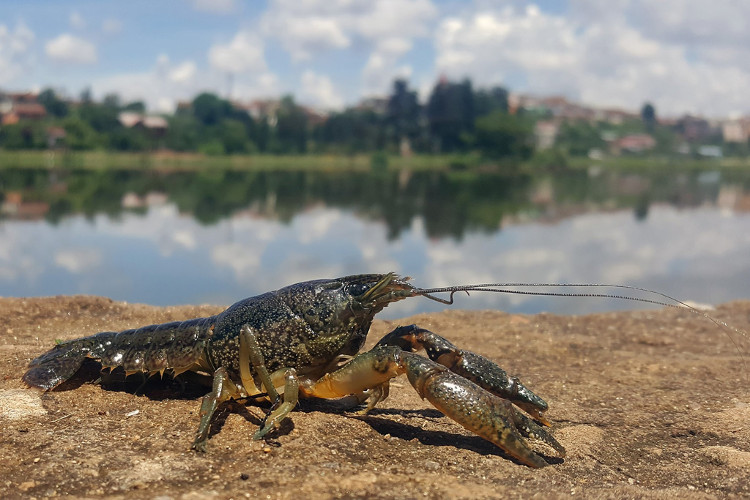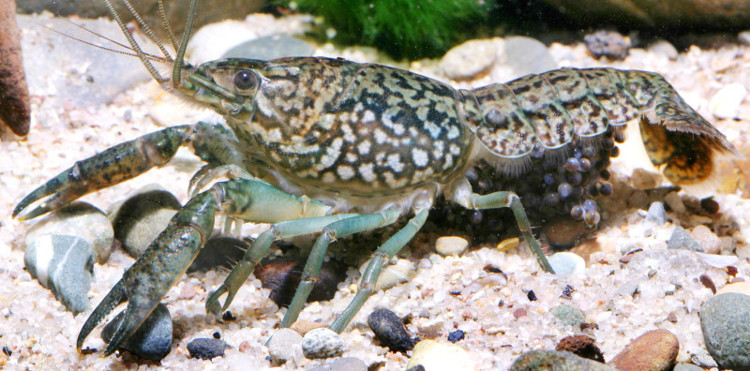Mutant crayfish are invading Europe thanks to its unique ability
Both Europe and parts of Africa and some Asian countries like Japan are sharing the plight of this monstrous shrimp.
Crayfish - or crayfish (or ground lobster) - is the common name for more than 500 different species of freshwater crayfish. And like all other shrimp, they reproduce sexually - that is to say, " sex " between two opposite sexes to maintain the race.
But you know, a crayfish is invading Europe because of its "unique" ability in shrimp species - that is cloning .

Marinated crayfish are invading Europe.
The shrimp we are talking about are marmokrebs (also called marble crayfish) . It is unclear why all the female crayfish in this species are mutated, so they can replicate themselves without the need for male shrimp.
Because of that, the number of marinated crayfish is increasing at a dizzying rate, and now they have almost invaded Europe and part of Africa.
It is known that this mutated shrimp was found in 1995, then it began to spread from Germany to Europe, then Africa. According to Gerhard Scholtz - an evolutionary biologist at Humboldt University (Berlin, Germany): "These shrimp are quite a dangerous species." The reason because they reproduce so quickly, at the same time endangering native animals because of their aggressive nature.

This mutated shrimp was found in 1995.
In a recent study published in Nature Ecology and Evolution, experts from the German Cancer Research Center tried to analyze the genome of 11 shrimp, to see why they could increase numbers. So fast. As a result, all 11 shrimp have the same genome - proving they were born by cloning from a single individual.
According to experts, things could start from an accident 25 years ago when a German hobbyist bought the crayfish. He called it Texas crayfish. But then this person was shocked when the shrimp spawned hundreds of eggs at a time, and became more and more "buoyant" .
In fact, this person must immediately destroy the shrimp. But no, he let it go, and then it appeared in a pet store in Germany.
It must be said that the owner of a pet shop has a bargain, because this shrimp does not need male shrimp but can still lay eggs. All shrimp are children, because they are clones of mother shrimp. Moreover, male prawns of different species cannot breed with marble shrimp anymore, although they can still do " sex " with each other.
When the mutant shrimps are sold, they reproduce extremely fast, then the owner releases them into rivers and lakes. Finally, Marmokreb shrimp begin to invade all of Europe, attacking both Japan and Madagascar. There are no specific statistics, but experts believe that the number of shrimp is increasing day by day.

They reproduce too quickly, too much.
Currently, the European Union (EU) has officially banned all activities related to this shrimp species, including trade, storage, distribution or release of shrimp into the environment.
"This is an evolutionary case in the shortest time ever witnessed" - Frank Lyko, genetic director at the German Cancer Research Center.
"Normally genetic cells will have to change over time. But this is a very rare case."
However, things are not necessarily too dark. Although this shrimp is harmful, their evolution also gives us a way to fight cancer, because the shrimp's ability to replicate is similar to how cancer develops.
The reason is because, although all Marmokrebs crayfish are cloned from the same genome. but they can still adapt to many different environments, thanks to the so-called " epigenetic mechanism" found in DNA.
This mechanism allows genetic information to be separated, acting like a "switch on and off" switch to genes that are suitable for the environment. That's why they can spread very quickly without fear of any disease attack.
Experts are now looking to use this shrimp to learn more about the mechanism of cancer development.
- Europe at risk of radiation radiation
- Origin and nutritional value of earth lobster
- The truth about the lobster species
- Demonstration mutant shrinks the body to wear a 3-year-old shirt
- 33 most unique borders in Europe
- The fierce fight against invading creatures
- Mutant deer has speckled fur
- Superman will be born in the next 30 years
- Detection of the Eibi1 mutant gene in wild barley plants
- Strange mutant creatures
- Unique: Colorful dragon catfish is not a joke
- Strange wild creatures threaten the European sea
 Animal 'suffering' after hibernation
Animal 'suffering' after hibernation Why do goats climb well?
Why do goats climb well? Scientists were surprised to see chimpanzees eating turtles
Scientists were surprised to see chimpanzees eating turtles Giant catfish died deadly due to drought in Thailand
Giant catfish died deadly due to drought in Thailand